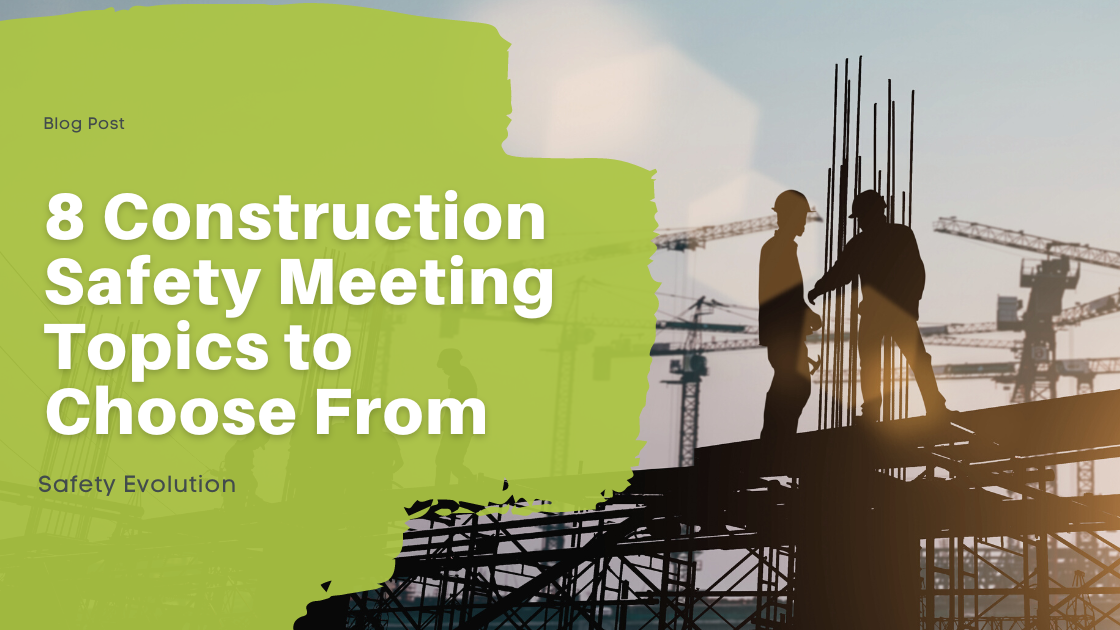Safety in construction is not a one-and-done arrangement. To ensure that a site or project is as safe as possible, a strong safety culture must be established which includes ongoing education, reminders, and discussions around all aspects of safe work.
Safety meetings, sometimes referred to as toolbox talks, are an essential part of any safety program. They keep important concepts, topics, and guidelines top of mind for everyone who needs to know and remember. They also encourage discussion, feedback, and accountability from the workers who are on the front lines and know what works and what doesn’t.
One of the most essential parts of a safety meeting agenda is, of course, the topic. Focusing on one specific area of concern each time allows the opportunity to properly highlight that topic and discuss it in depth. The following are a few popular safety meeting topics applicable on many construction sites.
- PPE (personal protective equipment)
- Hazard communication and identification
- Lockout and tag-out procedures
- Construction safety training
- First aid
- Fall protection
- Fire safety
- Electrical safety
Personal Protective Equipment - PPE
Part of each worker taking responsibility for their own safety is ensuring that they obtain and correctly wear or use the appropriate personal protective equipment. Management, in turn, must provide the necessary equipment and provide training and guidelines around how to use it.
Personal protective equipment ranges from the ubiquitous hard hat for protection against falling objects to basic hand protection like silicon gloves used as a barrier against bodily fluids or eye protection such as safety glasses—which means that there is plenty to discuss in a construction safety meeting on the topic. In fact, such a wide-ranging toolbox topic might span a series of meetings.
Hazard Communication and Identification
It’s essential that everyone on the worksite is aware of the major hazards posing a risk to their safety. Generally, this starts with a hazard identification and assessment program initiated and undertaken by management or a site safety committee. The results and findings from these should be freely shared with the workers, and this can be done during a safety meeting or toolbox talk.
Regular updates on identified hazards and the protocols in place to mitigate them should be a common feature of meetings, ensuring that everyone stays in the loop. Safety meetings are also an opportunity to collect information straight from the shop floor, so to speak. Workers should be encouraged to share near misses and general safety concerns, which may offer insight to those responsible for hazard identification.
Lockout and Tag-out Procedures - LOTO
Although a very specific aspect of overall safety, lockouts, and tagouts are instrumental in keeping workers safe. Lockout programs ensure that energy sources to a piece of equipment are isolated before the item is serviced or worked on, reducing the chances of harm to those doing the service or repair. Basically, they eliminate the risk of someone accidentally or unknowingly turning something on while someone else is in a precarious position.
Locking out a piece of machinery or equipment should physically lock it in safe mode. Tagout means to attach tags with information including the name of the person who performed the lockout and any other relevant details.
A safety meeting can go over these procedures to make sure anyone working on or with industrial machinery and equipment is very familiar with them.
Construction Safety Training
Staying up to date with training, whether it’s required by a governing body like CCOHS or OSHA or simply highly recommended for workers doing specific jobs in the construction industry, is crucial. Providing knowledge to workers and empowering them to keep themselves and others safe is an investment not only in them personally but in the company as a whole and the productivity of the site or project.
Discussing available worker safety training opportunities during a safety meeting can get employees excited about upskilling. Tools like our employee training matrix make it easy to see who needs to attend or refresh which training courses.
First Aid
A refresher on some basic first aid skills is a great way to spend a safety meeting a few times a year. While it is generally compulsory to have a person or people properly trained in first aid on-site at all times, basic skills can be imparted to every worker during toolbox talks and safety meetings so they have some idea of what to do while waiting for a first aid responder or medical professional.
A safety meeting first aid session might include treating—or at least preventing further harm from—sprains, burns, heat stress or hypothermia, back injuries, and other common injuries and ailments.
Fall Protection
Falling from a height is a fear for many people in general, not only construction workers—but there are many more opportunities for it to happen on a construction job site than in most other professions. Safety meetings about fall protection, including issues like ladder safety, ensure that the risks and safety measures are at the front of everyone’s minds. They can also reassure workers that fall prevention is something taken seriously by management.
Fire Safety
This construction safety topic should be a regular on the roster. With electric tools, construction materials, gas cylinders, flammable liquids, and spark-throwing equipment like welders and blowtorches commonplace on job sites, fire is an omnipresent risk. In Auckland, New Zealand, hundreds of millions of dollars worth of damage was done to a convention center under construction and the entire CBD affected by a large fire thought to have been caused by a worker leaving a blowtorch on when on a break.
A fire safety topic might include the proper use of equipment to prevent fires, correct handling of flammable materials, the location of fire extinguishers and when it is appropriate to use them, and any fire-related safety rules that exist for the particular site.
Electrical Safety
Electrics are a major hazard on job sites. While any significant electrical work should be left to qualified electricians, construction workers often come into contact with unfinished wiring, sometimes even power lines. They must also often use power hand tools or powered machinery and heavy equipment.
Top tips to cover during an electrical safety meeting might include:
- How to properly use, store, and care for power tools—basic tool safety.
- The importance of voltage regulators and circuit breakers.
- How to keep extension and appliance cords tidy and out of the way.
- How to assess electrical risk before starting work.
- Appropriate PPE for working with electricity.

Stay Safe with These and Other Safety Meeting Topics
Meetings and toolbox talks are not just venues for getting safety-related messages across, but they are an effective and invaluable way of doing so. They also help site management collect information straight from the horses’ mouths, so to speak, and provide opportunities for discussion across all sections of the workforce. Done right, with the right topics, they contribute to a strong workplace safety record and also a robust safety culture with open communication and personal accountability by all workers.
Paperwork is part of a safe site, there’s no way around it—but safety management software can cut down on the work involved in forming and executing a safety program as well as the physical bits of paper floating about.
Safety Evolution's Free Toolbox Talk Download Package
Finding toolbox talks for your safety meetings last minute can be a hassle.
Download this free package of weekly toolbox talks such as Hand Tool Safety, Forklift Safety, Trench Safety, Workplace Violence, Housekeeping toolbox talk, and more to make life easy!
Sign up below to receive our weekly newsletter with helpful safety content including weekly toolbox talks!



